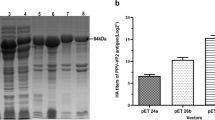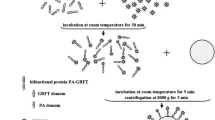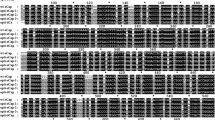Abstract
Nipah Virus (NiV) is an emerging zoonotic paramyxovirus that can be fatal in humans and various types of animals. The phospho (P) protein of NiV plays an important role in RNA synthesis, replication, and genome synthesis. In this study, the NiV P gene was cloned into a pTrcHis2-TOPO vector and the recombinant protein containing a His-tag was produced in Escherichia coli. SDS-PAGE and Western blot analysis using the anti-His antibody confirmed the protein expression. An optimization study of E. coli fermentation showed that the optimal cultivation temperature was 37°C, while the optimal induction time for P protein expression was at 9 h with 1 mM IPTG. Solubility analysis showed that E. coli cultivated at 37°C produced the highest fraction (70%) of soluble P protein. The recombinant P protein was purified from clarified E. coli lysate using an immobilized metal affinity chromatography (IMAC) technique to a purity of 92.67%, with a purification factor of 11.58. The purified P protein strongly reacted with the anti-NiV swine sera collected during a NiV outbreak, suggesting its potential as a diagnostic reagent.
Similar content being viewed by others
References
Chua, K. B., W. J. Bellini, P. A. Rota, B. H. Harcourt, A. Tamin, S. K. Lam, T. G. Ksiazek, P. E. Rollin, S. R. Zaki, W. J. Shieh, C. S. Goldsmith, J. T. Roehrig, B. Eaton, A. R. Gould, J. Olson, H. Field, P. Daniel, A. E. Ling, C. J. Peters, L. J. Anderson, and B. W. J. Mahy (2000) Nipah virus: A recently emergent deadly paramyxovirus. Science 288: 1432–1435.
Harcourt, B. H., L. Lowe, A. Tamin, X. Liu, B. Bankamp, N. Bowden, P. E. Rollin, J. A. Comer, T. G. Ksiazek, M. J. Hossain, E. S. Gurley, R. F. Breiman, W. J. Bellini, and P. A. Rota (2005) Genetic characterization of Nipah virus, Bangladesh, 2004. Emerg. Infect. Dis. 11: 1594–1597.
Halpin, K., P. L. Young, H. E. Field, and J. S. Mackenzie (2000) Isolation of Hendra virus from pteropid bats: a natural reservoir of Hendra virus. J. Gen. Virol. 81: 1927–1932.
Chua, K. B., C. L. Koh, P. S. Hooi, K. F. Wee, J. H. Khong, B. H. Chua, Y. P. Chan, M. E. Lim, and S. K. Lam (2002) Isolation of Nipah virus from Malaysian Island flying foxes. Microb. Infect. 4: 145–151.
Wang, L. F., B. H. Harcourt, M. Yu, A. Tamin, P. A. Rota, W. J. Bellini, and B. T. Eaton (2001) Molecular biology of Hendra and Nipah viruses. Microb. Infect. 3: 279–287.
Lo, M. K. and P. A. Rota (2008) The emergence of Nipah virus, a highly pathogenic paramyxovirus. J. Clin. Virol. 43: 396–400.
Dillon, P. J. and G. D. Parks (2007) Role for the Phosphoprotein P subunit of the paramyxovirus polymerase in limiting induction of host cell antiviral responses. J. Virol. 81: 11116–11127.
Wang, L. F., M. Yu, E. Hansson, L. I. Pritchard, B. Shiell, W. P. Michalski, and B. T. Eaton (2000) The exceptionally large genome of Hendra virus: Support for creation of a new genus within the family Paramyxoviridae. J. Virol. 74: 9972–9979.
Chen, J. M., K. C. Yaiw, M. Yu, L. F. Wang, Q. H. Wang, G. Grameri, and Z. L. Wang (2007) Expression of truncated phosphoprotein of Nipah virus and Hendra virus in Escherichia coli for the differentiation of Henipavirus. Biotechnol. Lett. 29: 871–875.
Porath, J., J. Carlsson, I. Olsson, and G. Belfrage (1975) Metal chelate affinity chromatography, a new approach to protein fractionation. Nature 258: 598–599.
Hochuli, E., W. Bannwarth, H. Dobeli, R. Gentz, and D. Stuber (1988) Genetic approach to facilitate purification of recombinant proteins with a novel metal chelate adsorbent. J. Nature Biotechnol. 6: 1321–1325.
Sharma, S. and G. P. Agarwal (2001) Interactions of proteins with immobilized metal ions: role of ionic strength and pH. J. Colloid Interface Sci. 243: 61–72.
Chong, F. C., W. S. Tan, D. R. A. Biak, T. C. Ling, and B. T. Tey (2009) Purification of histidine-tagged nucleocapsid protein of Nipah virus using immobilized metal affinity chromatography. J. Chromatogr. B 877: 1561–1567.
Coligan, J. E., B. M. Dunn, H. L. Plooegh, D. W. Speicheir, and P. T. Wingfield (2000) Current Protocols in Proteins Science. pp. 5.2.10–5.2.11. John Wiley & Sons, Inc., NY, USA.
Tan, W. S., S. T. Ong, M. Eshagi, S. S. Foo, and K. Yusoff (2004) Solubility, immunogenicity and physical properties of the nucleocapsid protein of Nipah virus produced in Escherichia coli. J. Med. Virol. 73: 105–112.
Bradford, M. M. (1976) A rapid and sensitive method for the quantitation of microgram quantities of protein utilizing the principle of protein-dye binding. Anal. Biochem. 72: 248–254.
Yap, W. B., B. T. Tey, N. B. M. Alitheen, and W. S. Tan (2010) Purification of the His-tagged hepatitis B core antigen from unclarified bacterial homogenate using immobilized metal affinity-expanded bed adsorption chromatography. J. Chromatogr. A 1217: 3473–3480.
Towbin, H., T. Staehelin, and J. Gordon (1979) Electrophoretic transfer of proteins from polyacrylamide gels to nitrocellulose sheets: Procedure and some applications. Proc. Nat. Acad. Sci. USA. 76: 4350–4354.
Chan, Y. P., C. L. Koh, S. K. Lam, and L. F. Wang (2004) Mapping of domains responsible for nucleocapsid protein-phosphoprotein interaction of henipaviruses. J. Gen. Virol. 85: 1675–1684.
Wang, L. F., W. P. Michalski, M. Yu, L. I. Pritchard, G. Crameri, B. Shiell, and B. T. Eaton (1998) A novel P/V/C gene in a new member of the Paramyxoviridae family which causes lethal infection in humans, horses, and other animals. J. Virol. 72: 1482–1490.
Curran, J., J. Marq, and D. Kolakofsky (1995) An N-terminal domain of the Sendai paramyxovirus P protein acts as a chaperone for the NP protein during the nascent chain assembly step of genome replication. J. Virol. 69: 849–855.
Kho, C. L., W. S. Tan, and K. Yusoff (2002) Cloning and expression of the phosphoprotein gene of Newcastle disease virus in Escherichia coli. J. Biochem. Mol. Biol. Biophys. 6: 117–121.
Brian, J. S., D. R. Gardner, G. Crameri, B. T. Eaton, and W. P. Michalski (2003) Sites of phosphorylation of P and V proteins from Hendra and Nipah viruses: Newly emerged members of Paramyxoviridae. Virus Res. 92: 55–65.
Clemmitt, R. H. and H. A. Chase (2000) Facilitated downstream processing of a histidine-tagged protein from unclarified Escherichia coli homogenate using immobilized metal affinity expandedbed adsorption. Biotechnol. Bioeng. 67: 206–216.
Johnson, R. D., R. J. Todd, and F. H. Arnold (1996) Multipoint binding in metal-affinity chromatography II. Effect of pH and imidazole on chromatographic retention of engineered histidinecontaining cytochromes c. J. Chromatogr. A 725: 225–235.
Tan, Y. P., T. C. Ling, W. S. Tan, K. Yusoff, and B. T. Tey (2006) Recovery of histidine-tagged nucleocapsid protein of Newcastle disease virus using immobilized metal affinity chromatography. Proc. Biochem. 41: 874–881.
Porath, J. (1988) IMAC-Immobilized metal ion affinity based chromatography. Trends Anal. Chem. 7: 254–259.
Clemmitt, R. H., L. J. Bruce, and H. A. Chase (1999) On-line monitoring of the purification of GST-(His) from an unclarified Escherichia coli homogenate within an immobilized metal affinity expanded bed. Bioseparation 8: 53–67.
Author information
Authors and Affiliations
Corresponding author
Rights and permissions
About this article
Cite this article
Salvamani, S., Tey, B.T., Ng, W.C. et al. Production and purification of the phosphoprotein of Nipah virus in Escherichia coli for use in diagnostic assays. Biotechnol Bioproc E 16, 1166–1172 (2011). https://doi.org/10.1007/s12257-011-0095-6
Received:
Revised:
Accepted:
Published:
Issue Date:
DOI: https://doi.org/10.1007/s12257-011-0095-6




